| Grey duskhawker | |
|---|---|
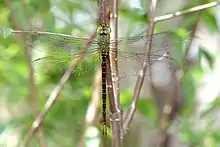 | |
| Male, Queensland, Australia | |
| Scientific classification | |
| Domain: | Eukaryota |
| Kingdom: | Animalia |
| Phylum: | Arthropoda |
| Class: | Insecta |
| Order: | Odonata |
| Infraorder: | Anisoptera |
| Family: | Aeshnidae |
| Genus: | Gynacantha |
| Species: | G. rosenbergi |
| Binomial name | |
| Gynacantha rosenbergi | |
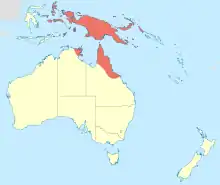 | |
Gynacantha rosenbergi is a species of dragonfly in the family Aeshnidae,[3] known as the grey duskhawker.[4] It inhabits still waters and is found in New Guinea,[2] Indonesia, through parts of northern Australia,[5] as well as islands in the south Pacific.[6]
Description
Gynacantha rosenbergi is a large dragonfly with a wingspan of about 119 mm and overall length about 85 mm.[7]
It is strikingly coloured. Its abdomen is a dark rusty brown with greenish-yellow markings and its thorax is pale green. Its eyes are green tinged with yellow and, like other members of the Aeshnidae family, are large and joined together at the top.[8] In front of its eyes the frons has a dark marking that looks like the letter 'T' when viewed from above.[4]
Abdomen
The abdomen is swollen where it joins the body, then forms a distinctive waist of about 2 mm at segment 3.[5] This waist is about half the width of segment 2, the segment closer to the main body. Beyond the waist, the abdomen tapers to the end.[9]
The second segment of the abdomen on a male has light green auricles, miniature ear-like projections on each side.
At the tip of their tails male dragonflies of the genus Gynacantha have a distinctive pair of long, slim, anal appendages with fine hairs on their inner sides. These hold the female during mating. For Gynacantha rosenbergi the tips of the male anal appendages are curved slightly under and towards each other, which helps to distinguish it from other members of its genus.[9]
Wings
Along the leading edge of the wing the nodus is about half way and, towards the wing tip, the pterostigma is a creamy coloured patch about 5 mm long.[2]
The wings are translucent. The base of the hindwing is a diffusely golden colour which may extend to the nodus.[9] Males have an angulated base to their hindwings, whereas females have a rounded base. The anal triangle, on the inboard edge of a male hindwing, is broad with three cells.[4][9]
The forewing triangle is stretched along the wing. The median space is clear without cross veins.[8]
Similarities to other species
Gynacantha rosenbergi is larger than Gynacantha dobsoni, which in many ways appears quite similar.[9]
Distribution
Gynacantha rosenbergi is not commonly recorded. It has been found from the Moluccas to Vanuatu and New Caledonia.[6] In Australia it has been recorded from coastal north-east Queensland, north from about Townsville. It has been found on Moa Island in Torres Strait and on Groote Eylandt in the Gulf of Carpentaria.[10]
Behaviour
Gynacantha rosenbergi inhabits still waters such as swamps and ponds. It rests in deep shade during the day and flies at dawn and dusk.[9]
Gallery
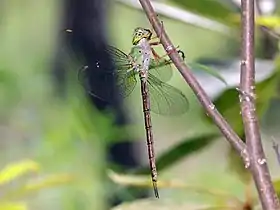 Grey duskhawker side view from below
Grey duskhawker side view from below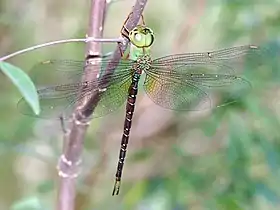 another view of the same dragonfly
another view of the same dragonfly.jpg.webp) Female wings
Female wings.jpg.webp) Male wings
Male wings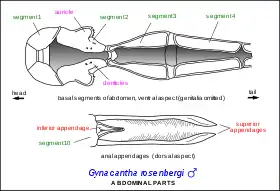 Diagram of male abdominal parts
Diagram of male abdominal parts Male anal appendages viewed from above. Note slightly curved tips. Australian Museum specimen K305406
Male anal appendages viewed from above. Note slightly curved tips. Australian Museum specimen K305406 Male anal appendages viewed from the side. Note slightly curved tips. Australian Museum specimen K305407
Male anal appendages viewed from the side. Note slightly curved tips. Australian Museum specimen K305407
See also
References
- ↑ Dow, R.A. (2017). "Gynacantha rosenbergi". IUCN Red List of Threatened Species. 2017: e.T83304904A83376320. doi:10.2305/IUCN.UK.2017-1.RLTS.T83304904A83376320.en. Retrieved 20 November 2021.
- 1 2 3 Brauer, F. (1867). "Bericht über die von Hrn. Dir. Kaup eingesendeten Odonaten. (Schluss.)". Verhandlungen der Zoologisch-Botanischen Gesellschaft in Wien (in German). 17: 287–302 [295] – via Biodiversity Heritage Library.
- ↑ "Species Gynacantha rosenbergi Kaup, 1867". Australian Faunal Directory. Australian Biological Resources Study. 2012. Retrieved 10 February 2017.
- 1 2 3 Theischinger, Günther; Hawking, John (2006). The Complete Field Guide to Dragonflies of Australia. Collingwood, Victoria, Australia: CSIRO Publishing. p. 154. ISBN 978-0-64309-073-6.
- 1 2 Theischinger, Gunther; Endersby, Ian (2009). Identification Guide to the Australian Odonata. Department of Environment, Climate Change and Water NSW. p. 217. ISBN 978-1-74232-475-3.
- 1 2 Watson, J.A.L.; Theischinger, G.; Abbey, H.M. (1991). The Australian Dragonflies: A Guide to the Identification, Distributions and Habitats of Australian Odonata. Melbourne: CSIRO. pp. 278 [191]. ISBN 0643051368.
- ↑ "Gynacantha rosenbergi". Atlas of Living Australia. CSIRO Australian National Insect Collection. 2014. Retrieved 27 March 2017.
- 1 2 Trueman, J.W.H. (2011). Odonata - A key to Australian families. Canberra.
{{cite book}}: CS1 maint: location missing publisher (link) - 1 2 3 4 5 6 Fraser, F.C. (1960). A handbook of the dragonflies of Australasia. Sydney: Royal Zoological Society of New South Wales. pp. 67 [37].
- ↑ "Gynacantha rosenbergi". Atlas of Living Australia. 2017. Retrieved 27 March 2017.
